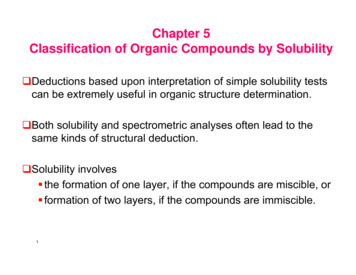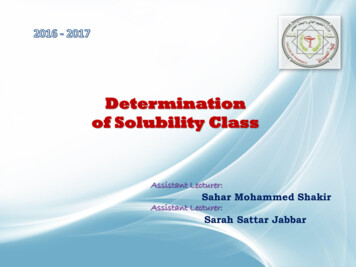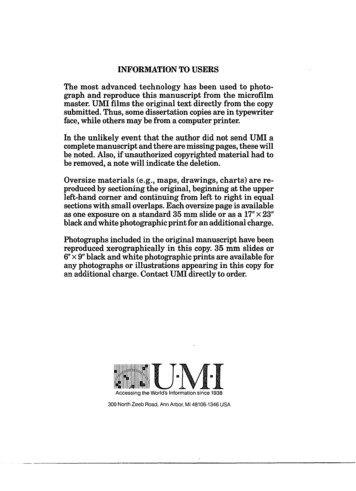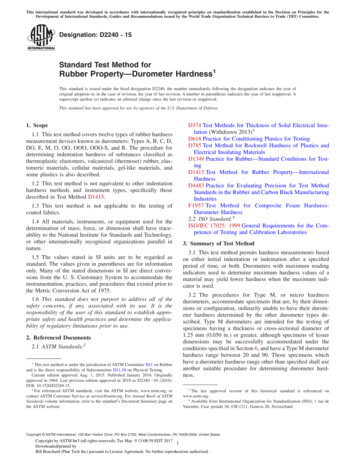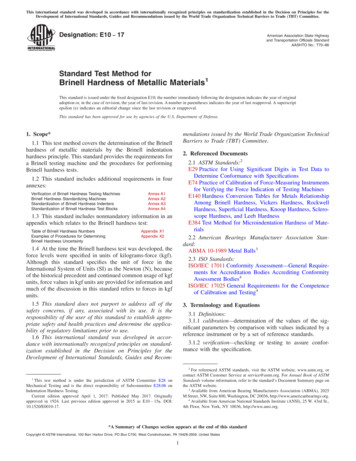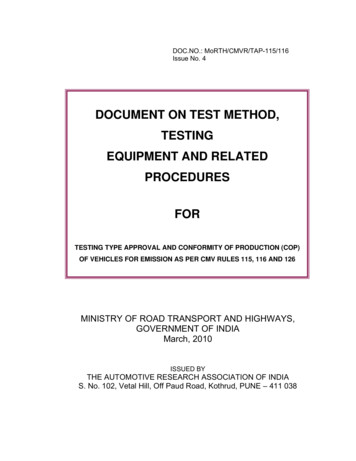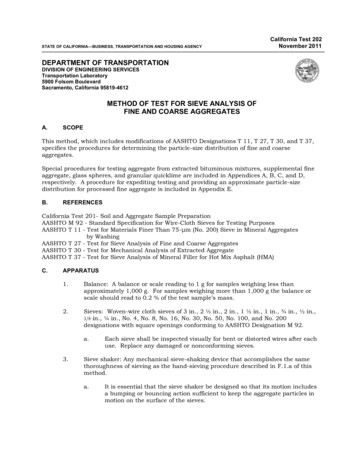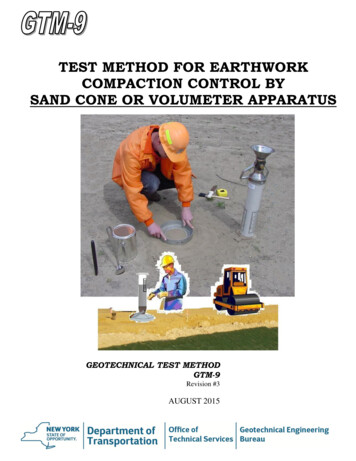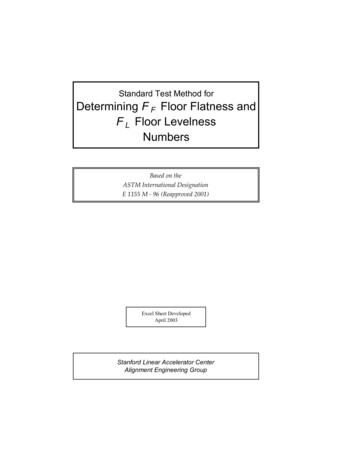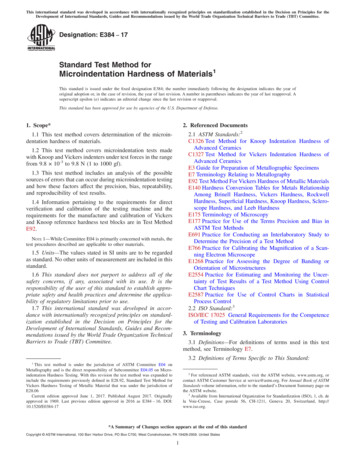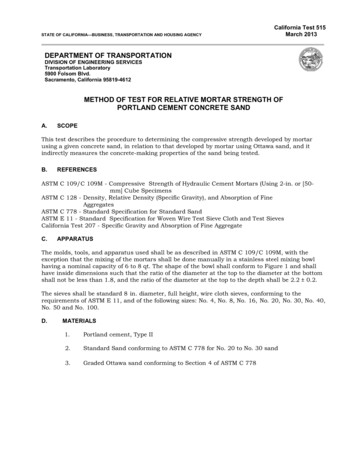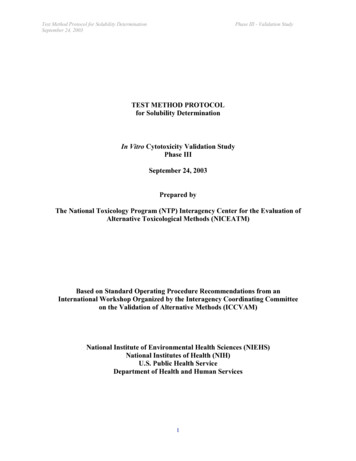
Transcription
Test Method Protocol for Solubility DeterminationSeptember 24, 2003Phase III - Validation StudyTEST METHOD PROTOCOLfor Solubility DeterminationIn Vitro Cytotoxicity Validation StudyPhase IIISeptember 24, 2003Prepared byThe National Toxicology Program (NTP) Interagency Center for the Evaluation ofAlternative Toxicological Methods (NICEATM)Based on Standard Operating Procedure Recommendations from anInternational Workshop Organized by the Interagency Coordinating Committeeon the Validation of Alternative Methods (ICCVAM)National Institute of Environmental Health Sciences (NIEHS)National Institutes of Health (NIH)U.S. Public Health ServiceDepartment of Health and Human Services1
Test Method Protocol for Solubility DeterminationSeptember 24, 2003Phase III - Validation StudyTEST METHOD PROTOCOLSolubility DeterminationPhase IIII.PURPOSEThe purpose of this study is to evaluate the cytotoxicity of test chemicals using the BALB/c 3T3Neutral Red Uptake (NRU) and normal human keratinocyte (NHK) cytotoxicity tests. The data willbe used to evaluate the intra- and inter-laboratory reproducibility of the assay and effectiveness of thecytotoxicity assay to predict the starting doses for rodent acute oral systemic toxicity assays. This testmethod protocol outlines the procedures for performing solubility determinations for the in vitrovalidation study organized by NICEATM and the European Centre for the Validation of AlternativeMethods (ECVAM) and sponsored by NIEHS, U.S. Environmental Protection Agency, and ECVAM.This test method protocol applies to all personnel involved with performing the solubility testing.A. Solubility TestThe solubility tests will be performed to determine the best solvent to use for each of the 60blinded/coded test chemicals to be tested in the 3T3 and NHK NRU cytotoxicity testsII. SPONSORA. Name:National Institute of Environmental Health Sciences (NIEHS); TheNational Toxicology Program (NTP) Interagency Center for theEvaluation of Alternative Toxicological Methods (NICEATM)B. Address:P.O. Box 12233Research Triangle Park, NC 27709C. Representative:Named RepresentativeIII. IDENTIFICATION OF TEST SUBSTANCES AND SOLVENTSA. Test Chemicals:60 Coded Chemicals (60)B. Solvents:Chemical Dilution Medium for 3T3 assay (See Section VII.B.1)Treatment Medium for NHK assay (See Section VII.B.2)IV. TESTING FACILITY AND KEY PERSONNELA. Facility Information1)2)3)4)5)6)7)Name:Address:Study Director:Laboratory Technician(s):Scientific Advisor:Quality Assurance Director:Safety Manager:2
Test Method Protocol for Solubility DeterminationSeptember 24, 2003Phase III - Validation Study8) Facility Management:B. Test Schedule1) Proposed Experimental Initiation Date:2) Proposed Experimental Completion Date:3) Proposed Report Date:V. TEST SYSTEMThe solubility test procedure is based on attempting to dissolve chemicals in various solvents with aincreasingly rigorous mechanical techniques. The solvents to be used, in the order of preference, arecell culture media, DMSO, and ethanol. Solubility shall be determined in a step-wise procedure thatinvolves attempting to dissolve a test chemical in the solvents (in the order of preference) at relativelyhigh concentrations using the sequence of mechanical procedures (Section VII.C.2.a). If thechemical does not dissolve, the volume of solvent is increased so as to decrease the concentration bya factor of 10, and then the sequence of mechanical procedures are repeated in an attempt tosolubilize the chemical at the lower concentrations.Determination of whether a chemical has dissolved is based entirely on visual observation. Achemical has dissolved if the solution is clear and shows no signs of cloudiness or precipitation.VI. DEFINITIONSA. Soluble: Chemical exists in a clear solution without visible cloudiness or precipitate.B. Documentation: all methods and procedures will be noted in a Study Workbook; logs will bemaintained for general laboratory procedures and equipment (e.g., media preparation, solubilitytesting, laboratory balance calibration); solubility reports will be in electronic and paper format;all data will be archived.VII.PROCEDURESA. Materials1. Technical Equipment[Note: Suggested brand names/vendors are listed in parentheses. Equivalents may be used.]a)b)c)d)e)Water bath: 37ºC 1ºCGlass tubes with caps (e.g., 5 mL)Laboratory balancePipetting aidPipettes, pipettors (multi-channel and single channel; multichannel repeater pipette),dilution blockf) Waterbath sonicatorg) Dry heat block (optional)2. Chemicals, Media, and Sera3
Test Method Protocol for Solubility DeterminationSeptember 24, 2003Phase III - Validation Studya) Dulbecco’s Modification of Eagle’s Medium (DMEM) without L-Glutamine; shouldhave high glucose [4.5gm/l] (e.g., ICN-Flow Cat. No. 12-332-54)b) L-Glutamine 200 mM (e.g., ICN-Flow # 16-801-49)c) Penicillin/streptomycin solution (e.g. ICN-Flow # 16-700-49)d) Dimethyl sulfoxide (DMSO), U.S.P. analytical grade (Store under nitrogen @ -20ºC)e) Ethanol (ETOH), U.S.P. analytical grade (100 %, non-denatured for test chemicalpreparation; 95 % can be used for the desorb solution)f) Keratinocyte Basal Medium without Ca (KBM“, Clonetics CC-3104) that is completedby adding the KBM“ SingleQuots“ (Clonetics CC-4131) to achieve the properconcentrations of epidermal growth factor, insulin, hydrocortisone, antimicrobial agents,bovine pituitary extract, and calcium (e.g., Clonetics Calcium SingleQuots“, 300 mMCaCl2, Clonetics # CC-4202).B. Preparations of Media and Solutions[Note: All solutions glassware, pipettes, etc., shall be sterile and all procedures should be carriedout under aseptic conditions and in the sterile environment of a laminar flow cabinet (biologicalhazard standard). All methods and procedures will be adequately documented. Completed mediaformulations should be kept at approximately 2-8 C and stored for no longer than two weeks.]1. 3T3 Chemical Dilution MediumDMEM (buffered with sodium bicarbonate) supplemented with (final concentrations inDMEM are quoted):4 mM200 IU/mL200 µg/mLGlutaminePenicillinStreptomycin2. NHK Treatment MediumKBM“ (Clonetics CC-3104) supplemented with KBM“ SingleQuots“ (Clonetics CC-4131)and Clonetics Calcium SingleQuots“ (CC-4202) to make 500 mL medium. Finalconcentration of supplements in medium are:0.0001 ng/mL5 mg/mL0.5 mg/mL30 mg/mL15 ng/mL0.10 mM30 mg/mLHuman recombinant epidermal growth factorInsulinHydrocortisoneGentamicinAmphotericin BCalciumBovine pituitary extractNOTE:KBM“ SingleQuots“ contain the following stock concentrations and volumes:0.1 ng/mL5.0 mg/mL0.5 mg/mL30 mg/mLhEGFInsulinHydrocortisoneGentamicin, 15 ug/mL Amphotericin-B40.5 mL0.5 mL0.5 mL0.5 mL
Test Method Protocol for Solubility DeterminationSeptember 24, 20037.5 mg/mLPhase III - Validation StudyBovine Pituitary Extract (BPE)2.0 mLClonetics Calcium SingleQuots“ are 2 mL of 300 mM calcium.165 ml of solution per 500 mL calcium-free medium equals 0.10 mM calcium in themedium.C. Determination of SolubilityThe preference of solvent for dissolving test chemicals is medium, DMSO, and then ethanol.Solubility shall be determined in a step-wise procedure that involves attempting to dissolve a testchemical at a relatively high concentration with the sequence of mechanical procedures specifiedin Section VII.C.2.a. If the chemical does not dissolve, the volume of solvent is increased so asto decrease the concentration by a factor of 10, and then the sequence of mechanical proceduresin Section VII.C.2.a are repeated in an attempt to solubilize the chemical at the lowerconcentrations. For testing solubility in medium, the starting concentration is 20,000 mg/ml (i.e.,20 mg/mL) in Tier 1, but for DMSO and ethanol the starting concentration is 200,000 mg/ml (i.e.,200 mg/mL) in Tier 2. Weighing out chemical for each solvent (i.e., medium, DMSO, ethanol)can be done all at once, if convenient, but solubility testing (at each tier that calls for more thanone solvent) is designed to be sequential - medium, then DMSO, then ethanol – in accordancewith the solvent hierarchy (see Figure 1). This allows for testing to stop, rather than continuetesting with less preferred solvents, if the test chemical dissolves in a more preferred solvent. Forexample, if a chemical is soluble in medium at a particular tier, testing may stop. Likewise, if achemical is soluble in DMSO at any tier, testing need not continue with ethanol. However, sincethe issue of primary importance is testing the solvents and concentrations of test chemicalrequired by any one tier, sequential testing of solvents may be abandoned if the lab can test moreefficiently in another way.1. Methoda) Tier 1 begins with testing 20 mg/mL each in Chemical Dilution Medium and TreatmentMedium (see Table 1). For each medium, weigh approximately 10 mg (10,000 mg) ofthe test chemical into glass tubes. Document the chemical weight. Add approximately0.5 mL of each medium into its respective tube so that the concentration is 20,000 mg/ml(20 mg/mL). Mix the solution as specified in Section VII.C.2.a. If complete solubilityis achieved in each medium, then additional solubility procedures are not needed.b) If the test chemical is insoluble in either Chemical Dilution Medium or TreatmentMedium, proceed to Tier 2 by adding enough medium, approximately 4.5 mL, to attemptto dissolve the chemical at 2 mg/mL by using the sequence of mixing proceduresspecified in Section VII.C.2.a. If the test chemical dissolves in medium at 2 mg/mL, nofurther procedures are necessary. If the test chemical does NOT dissolve in one mediumor the other (if both are tested in this tier), weigh out approximately 100 mg test chemicalin a second glass tube and add enough DMSO to make the total volume approximately0.5 mL (for 200 mg/mL) and attempt to dissolve the chemical as specified in SectionVII.C.2.a. If the test chemical does not dissolve in DMSO, weigh out approximately 100mg test chemical in another glass tube and add enough ethanol to make the total volumeapproximately 0.5 mL (for 200 mg/mL) and attempt to dissolve the chemical as specifiedin Section VII.C.2.a. If the chemical is soluble in either solvent, no additional solubilityprocedures are needed.5
Test Method Protocol for Solubility DeterminationSeptember 24, 2003Phase III - Validation Studyc) If the chemical is NOT soluble in one or both media, DMSO, or ethanol at Tier 2, thencontinue to Tier 3 in Table 1 by adding enough solvent to increase the volume of thethree (or four) Tier 2 solutions by 10 and attempt to solubilize again using the sequenceof mixing procedures in Section VII.C.2.a. If the test chemical dissolves, no additionalsolubility procedures are necessary. If the test chemical does NOT dissolve, continuewith Tier 4 and, if necessary, Tier 5 using DMSO and ethanol. Tier 4 begins by dilutingthe Tier 3 samples with DMSO or ethanol to bring the total volume to 50 mL. Themixing procedures in Section VII.C.2.a are again followed to attempt to solubilize thechemical. Tier 5 is performed, if necessary, by weighing out another two samples of testchemical at 10 mg each and adding 50 mL DMSO or ethanol for a 200 mg/mLsolution, and following the mixing procedures in Section VII.C.2.a.Example: If complete solubility is not achieved at 20,000 mg/mL in either ChemicalDilution Medium or Treatment Medium at Tier 1 using the mixing procedures specifiedin Section VII.C.2.a, then the procedure continues to Tier 2 by diluting the solution to 5mL (with either of the appropriate media) and mixing again as specified in SectionVII.C.2.a. If the chemical is not soluble in Chemical Dilution Medium or TreatmentMedium, two samples of 100 mg test chemical are weighed to attempt to solubilize inDMSO and ethanol at 200,000 mg/mL (i.e., 200 mg/mL). Solutions are mixed followingthe sequence of procedures prescribed in Section VII.C.2.a in an attempt to dissolve. Ifsolubility is not achieved at Tier 2, then the solutions (Chemical Dilution Medium and/orTreatment Medium, DMSO, and ethanol) prepared in Tier 2 are diluted by 10 so as to test200 mg/mL in media, and 20,000 mg/mL in DMSO and ethanol. This advances theprocedure to Tier 3. Solutions are again mixed as prescribed in Section VII.C.2.a in anattempt to dissolve. If solubility is not achieved in Tier 3, the procedure continues to Tier4, and to 5 if necessary (see Figure 1 and Table 1).6
Test Method Protocol for Solubility DeterminationSeptember 24, 2003Phase III - Validation StudyTable 1. Determination of Solubility in Chemical Dilution Medium, Treatment Medium, DMSO, orEthanolTIER1234Total Volume0.5 mL5 mL50 mL20,000 mg/mL2,000 mg/mL200 mg/mL(20 mg/mL)(2 mg/mL)(0.20 mg/mL)0.5 mL5 mL50 mL200,000 mg/mL20,000 mg/mL2,000 mg/mL(200 mg/mL)(20 mg/mL)(2 mg/mL)5Chemical DilutionMedium/TreatmentMediumConcentration of TestChemical(Add 10 mg to a tube.Add enough medium toequal the first volume.Dilute to subsequentvolumes if necessary.)Total VolumeDMSO/EthanolConcentration of TestChemical(Add 100 mg to a largetube. Add enough DMSOor ethanol to equal the firstvolume. Dilute withsubsequent volumes ifnecessary.)Total VolumeDMSO/EthanolConcentration of TestChemical(Add 10 mg to a largetube. Add enough DMSOor ethanol to equal 50 mL.)Equivalent Concentrationon Cells50 mL200 mg/mL(0.2 mg/mL)10,000 mg/mL1000 mg/mL100 mg/mL10 mg/mL(10 mg/mL)(1 mg/mL)(0.1 mg/mL)(0.01 mg/mL)1 mg/mL(0.001mg/mL)[NOTE: The amounts of test chemical weighed and Chemical Dilution Medium andTreatment Medium added may be modified from the amounts given above, provided thatthe targeted concentrations specified for each tier are tested.]7
Test Method Protocol for Solubility DeterminationSeptember 24, 2003Phase III - Validation StudyFigure 1. Solubility Flow ChartSTEP 1:STEP 2:STEP 3:STEP 4:STEP 5:STEP 6:TIER 120 mg/mL test chemical (TC) in 0.5 mL Chemical Dilution Medium and TreatmentMedium: if TC soluble in both media, then STOP. if TC insoluble in one medium, then go to STEP 2.TIER 22 mg/mL TC in medium (one or
V. TEST SYSTEM . The solubility test procedure is based on attempting to dissolve chemicals in various solvents with a increasingly rigorous mechanical techniques. The solvents to be used, in the order of preference, are cell culture media, DMSO, and ethanol. Solubility shall be determined in File Size: 274KBPage Count: 10
